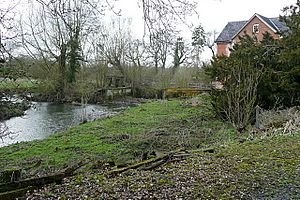Stanford End Mill and River Loddon facts for kids
| Site of Special Scientific Interest | |
 |
|
| Area of Search | Berkshire |
|---|---|
| Interest | Biological |
| Area | 11.8 hectares (29 acres) |
| Notification | 1987 |
| Location map | Magic Map |
Stanford End Mill and River Loddon is a special natural area in Berkshire, England. It covers about 11.8 hectares (that's like 29 football fields!). This area is known as a Site of Special Scientific Interest (SSSI). It includes the meadows around Stanford End Mill and a 4-kilometer (about 2.5-mile) part of the River Loddon. This river stretch runs between Stanford End and Sheep Bridge, which is north-west of Swallowfield.
The old mill building was constructed a long time ago, in the early Victorian era. It was part of the large Stratfield Saye estate. This whole area is protected because it's home to many important plants and animals.
Contents
What Makes This Place Special?
Stanford End Mill and River Loddon is a "Site of Special Scientific Interest" (SSSI). This means it's one of the best places in the country for wildlife and nature. The government protects these areas to make sure their special plants, animals, and habitats can thrive. It's like a super important nature reserve!
The site is important for its biological features. This means it's valued for its living things, like plants and animals. Protecting this area helps keep the natural world healthy for everyone.
Amazing Animals You Might See
This special place is home to many different creatures. Some of them are quite rare or important.
Mammals Living by the Water
One of the most interesting mammals here is the European water vole. These small, furry animals look a bit like guinea pigs. They love living near water, digging burrows in riverbanks. Water voles are becoming rare in many parts of the UK. So, finding them here shows how healthy the river environment is.
Birds of the River and Meadows
The river and surrounding areas are perfect for many types of birds. You might spot some common water birds like the Moorhen and the Coot. These birds are often seen swimming or walking along the water's edge. The graceful Mute swan also makes its home here.
Keep an eye out for the tiny Little grebe. This small diving bird is often hard to spot. If you are lucky, you might even see a Common kingfisher. Kingfishers are famous for their bright blue and orange feathers. They fly very fast and dive into the water to catch fish.
Tiny Creatures: Invertebrates
Even the smallest creatures are important! This area is home to special invertebrates. These are animals without backbones, like insects and snails. Some rare types of snails, such as Vertigo antivertigo and Vertigo moulinsiana, live here. These tiny snails need very specific damp conditions to survive. Their presence shows the good quality of the wetland habitat.
Wonderful Plants Growing Here
The plants at Stanford End Mill and River Loddon are just as special as the animals. They create the perfect habitat for all the wildlife.
Trees Along the Riverbank
Along the river, you'll find different kinds of trees. Alder trees often grow near water. Their roots help to hold the riverbanks together. You might also see Salix alba, which is a type of willow tree. Strong Ash trees and mighty Quercus robur (English oak) also add to the beauty of the landscape.
Wildflowers and Water Plants
The meadows and river are full of beautiful and important plants. In spring, you might see the amazing Fritillaria meleagris, also known as the snake's head fritillary. This flower has a unique checkered pattern on its petals. It's quite rare and very beautiful.
Many water plants grow in the River Loddon. Potamogeton nodosus and Potamogeton pectinatus are types of pondweeds. They grow underwater and provide food and shelter for fish and insects. You might also spot the bright yellow flowers of Nuphar lutea, which is the yellow water-lily.
In the meadows, common wildflowers like Cuckoo flower (Cardamine pratensis) and Meadowsweet (Filipendula ulmaria) add splashes of color. These plants are important food sources for insects like bees and butterflies. Other interesting plants include Ophioglossum vulgatum, also known as adder's-tongue fern, which has a very unique leaf shape.

